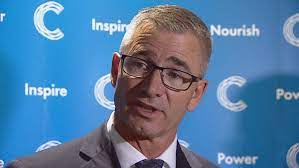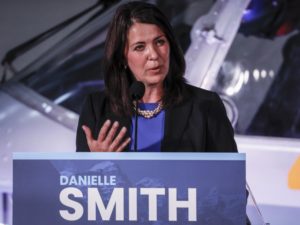Between the first quarter update at the end of August and the mid-year update of November 25th? a new premier took charge. In the tbf-2022-23-first-quarter (as its PDF is known) the province expected to collect $75.9 billion in revenue. In tbf-2022-23-mid-year total revenue is $76.9 billion. The Mid-term Update was called “Strong economy, strong Alberta” equating Alberta to economy. The press conference video is here.
Spending
Spending has increased from $62.1-billion in the 2022 Budget, including COVID-19 recovery spending, to $64.7-billion in the fiscal update or by $2.6-billion. Increased spending comes from $300-million in electricity rebates, “affordability initiatives” of $1.2-billion, $308 million for higher costs of selling oil, $340 million for Health including $174 million for the Alberta Medical Association agreement, $126 million for other collective bargaining agreements, and $40 million for various other programs, including primary care nursing, resident physicians, homelessness, and the addictions and crisis hotline, $50 million for Justice and Solicitor General including $22 million for judicial compensation, $15 million for victims services, and $6 million for legal aid (Fiscal Update, p. 8). The new regime will continue to use the windfall to strategically invest in initiatives both through its operating budget and its capital budget to shore up support in contestable constituencies. For example on 30 November Graham Construction was awarded a contract to build a major interchange at Queen Elizabeth II Highway and 65th Avenue of Leduc. Construction is expected to begin in late 2022. and will cost $112-million. Leduc-Beaumont was a riding won by the NDP in 2015 and will be closely fought during the election period.

Revenue
Bitumen royalty revenue was actually down $733 million from the Q1 update. Bitumen royalties now constitute about one-quarter of total government revenue including federal transfers. All non-renewable resource revenue constitutes a whopping 37 per cent of total government revenue. As reported in Abpolecon.ca only four producers account for 25 to 30 per cent of all government own source revenue. Offsetting the good news on royalties was a drop in Investment income of $2-billion as financial markets are expected to perform poorly.
This analysis will dive a little deeper into the calculations in determining how much money the Alberta government takes from only four oilsands producers. According to the mid-year update bitumen royalties are expected to fetch $19.353-billion. The mid-year update also estimates that bitumen production will average about 3,297,000 barrels per day. Table 1 below records the first step is to ascertain the Big Four’s portion of total bitumen production. This data was drawn from Oilsands Magazine in early November.
Big Four- Royalties
Oilsands Magazine reports production capacity which is different from actual production. The table below shows estimated capacity.
|
Table 1- Total Production Capacity (bbl/day) |
||
|
Producers |
In-situ |
Mine |
|
Athabasca |
32,000 |
|
|
CNRL |
387,500 |
620,000 |
|
Cenovus |
500,000 |
|
|
CNOOC |
92,000 |
|
|
Connacher |
20,000 |
|
|
Conoco-Phillips |
148,000 |
|
|
Everest Canadian Resources |
12,000 |
|
|
Greenfire Resources |
30,000 |
|
|
Harvest Operations |
10,000 |
|
|
Imperial Oil |
270,000 |
240,000 |
|
International Petroleum Corp |
500 |
|
|
MEG Energy |
100,000 |
|
|
PetrocChina |
35,000 |
|
|
Strathcona Resources |
66,000 |
|
|
Suncor |
333,000 |
494,000 |
|
Sunshine Oilsands |
5,000 |
|
|
Imperial Oil -Syncrude |
25% |
101,250 |
|
Sinopec Oil Sands partnership |
9% |
36,450 |
|
CNOOC Oil Sands Canada |
7% |
29,160 |
|
Suncor |
59% |
237,735 |
|
Syncrude |
405,000 |
|
|
Totals |
2,446,000 |
1,354,000 |
|
Total in-situ and mine production |
3,800,000 |
|
|
Source: https://www.oilsandsmagazine.com/projects/bitumen-production |
||
As table 2 below shows the Big Four holds 84 per cent of the production capacity in the in-situ and mining segments of the oilsands industry.
|
Table 2- Big Four Production Capacity |
|
|
Company |
(bbl/day) |
|
Cenovus |
500,000 |
|
CNRL |
1,007,500 |
|
Imperial Oil, incl. Syncrude |
611,250 |
|
Suncor, incl. Syncrude |
1,064,735 |
|
Total production per Oil Sands magazine |
3,800,000 |
|
Total production Big Four |
3,183,485 |
|
Percentage Big Four |
84% |
The next table shows the actual bitumen production of the Big Four in the July1-September 30 quarter. This confirms that the 84 per cent estimate is a realistic estimate to use since there will be variances depending on shut-downs etc.
|
Table 3- Big Four Production -Actual |
||
|
Company |
bbl/day |
|
|
Cenovus bbl/day |
585,000 |
Third Quarter MDA, p. 20. |
|
CNRL bbl/day |
959,185 |
Third Quarter, MDA p. 10 |
|
Imperial Oil bbl/day w/o Syncrude |
414,000 |
Third Quarter, Financial Statements p. 18 |
|
Suncor bbl/day |
764,100 |
Third Quarter, Interim Report p. 1 |
|
Sub-total bbl/day |
2,722,285 |
|
|
Alberta estimated Bitumen Production (bbl/day) |
3,297,000 |
Mid-year report p. 19. |
|
Per cent of Big Four bbl/day |
82.6% |
|
Sources: Interim financial statements and Management Discussion and Analysis (MDA) of Cenovus, CNR, Imperial Oil, Suncor.
With expected bitumen revenue of $19.4 billion the Big Four would account for about 83 per cent of total bitumen royalties or about $16.1-billion. This figure also assumes that the Big Four’s timing of “full payout” makes no material difference to royalty payments of the other bitumen players.
Taxes payable
I assume that virtually all provincial taxes would be paid in Alberta since production, sales and number of employees are heavily weighed to Alberta. Companies would have an incentive to book as much taxable income in Alberta since corporate marginal rates are the lowest in the country. Of the 100 per cent of taxes payable I assume one-half of taxes go to the federal government. We also assume that there might be 10 per cent of taxes payable to governments outside Canada. Assuming that federal tax which is a 13 per cent rate and a 8 per cent Alberta tax means Alberta’s share should be about 38 per cent of federal taxes. This would equate to about 34 per cent of total taxes payable (which are not the same as cash taxes paid).
In order to calibrate whether 34 per cent of taxes is paid to Alberta in a 2019 report
Alberta Corporate Income Tax NAICS historicalprepared by Alberta Treasury Board and Finance showed the distribution of corporate taxes from 2014-15 to 2020-21 by sector. Surprisingly the oil and gas sector only accounted for less than 10 per cent of taxes payable. This probably understates a normal cycle because some of those years oil and gas producers were bleeding money and raising debt desperately. In addition, oilsands producers like Cenovus (Husky), Imperial and Suncor have significant refining operations which dominate Alberta’s manufacturing sector. which would add to the taxes paid by these companies. The calculations show that taxes by the Big Four would be upwards of 45 per cent of all corporate taxes. This estimate is less precise that the bitumen royalty calculation.
|
Table 4- Total Big Four Taxes payable and Royalties ($billions) |
||
|
Company |
$millions |
Source |
|
Cenovus |
2,028 |
Third Quarter, Interim Financial statements p.3. |
|
CNRL |
2,957 |
Third Quarter, Interim Financial statements p.2. |
|
Imperial |
1,592 |
Third Quarter, Interim Financial statements p.2 |
|
Suncor |
2,442 |
Third Quarter, Interim Report p.51 |
|
Subtotal |
9,019 |
|
|
less international taxes |
(902) |
|
|
Estimated Canadian taxes payable |
8,117 |
|
|
Canadian statutory rate |
15% |
|
|
Alberta Statutory rate |
8% |
|
|
Alberta portion |
35% |
|
|
Alberta taxes payable |
2,823 |
|
|
Estimated royalties @ 83 per cent |
16,063 |
|
|
Total estimated royalties and taxes |
18,886 |
|
|
Alberta Own Source Revenue (excluding federal transfers-$billions) |
64,414 |
Mid-year report, p. 4. |
|
Big Four Per cent of Total Own Source Revenue (excluding federal transfers) |
29.3% |
|

This analysis shows that nearly one-third of Alberta’s own source revenue comes from four companies. With total revenue of $76.9-billion, including federal transfers, the Big Four still contribute a whopping one out of every four revenue dollars to the Alberta Crown. It is little wonder that, writing in June 2021 before political ambition set in, Danielle Smith argued Alberta’s principal problem was “not a lack of diversification in industry… (but) “ is a lack of diversification in the provincial government’s source of revenues, and a lack of innovation in the public service as a whole. (p.6)”
Related Posts